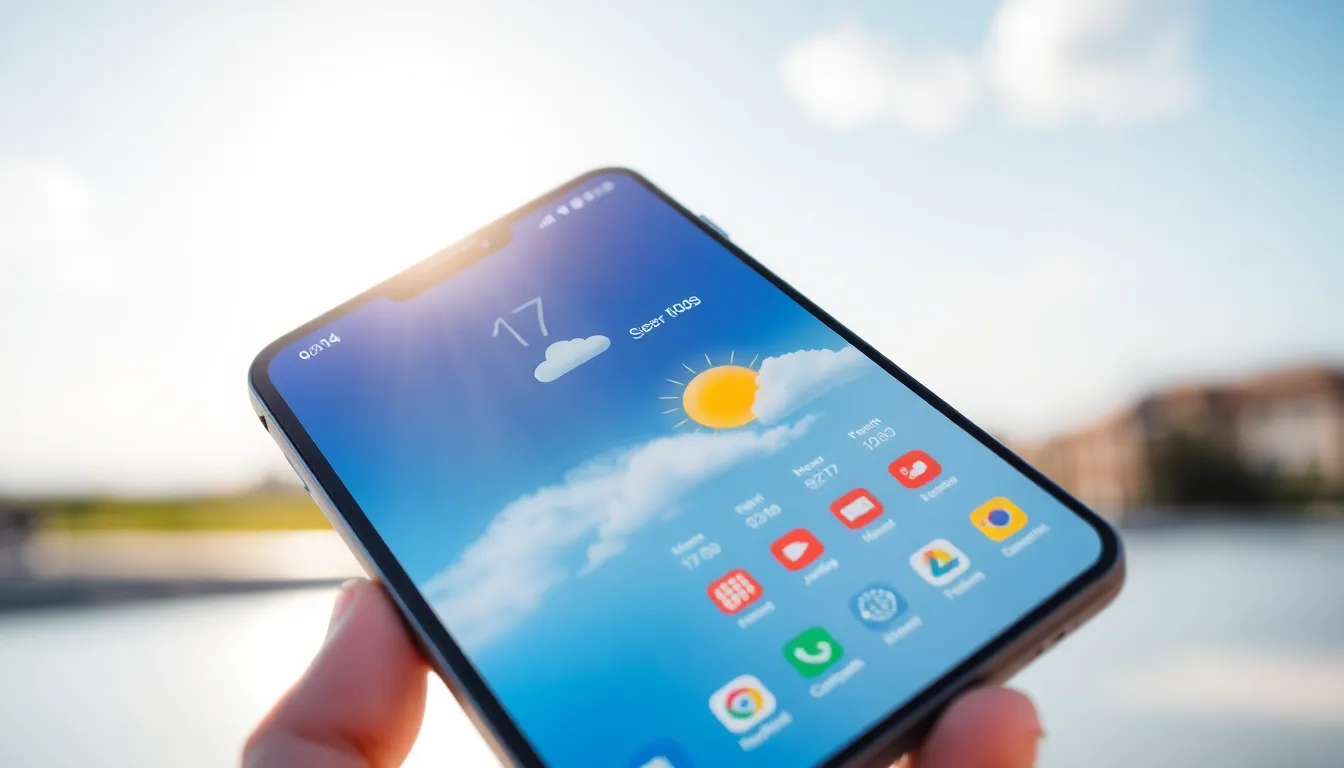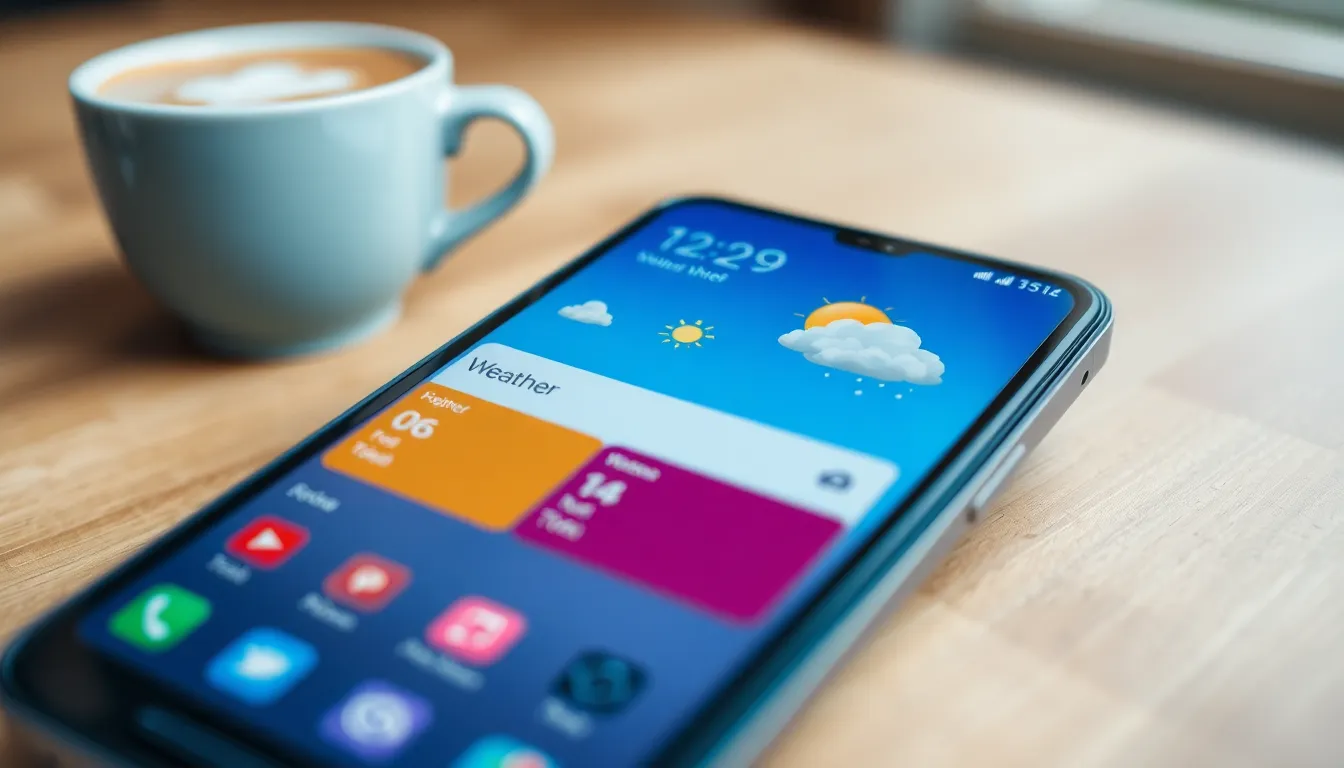Ever wondered why the weather app always seems to get it wrong? Maybe it’s time to take matters into your own hands. Imagine crafting your very own weather app, one that predicts rain with the accuracy of a seasoned meteorologist—or at least better than your friend’s cousin who swears by his “gut feeling.”
Table of Contents
ToggleOverview of Weather App Coding Project
Developing a personal weather app involves several essential components. Users seek accurate forecasts along with a user-friendly design. Integrating reliable APIs for real-time weather data enables the app to provide timely and precise predictions.
Functionality plays a critical role in user experience. Including features like location tracking, customizable notifications, and interactive maps enhances usability. Data visualization elements, such as graphs and charts, help users better understand weather patterns.
Understanding programming languages is vital during development. Choosing languages like JavaScript, Python, or Swift facilitates creating a responsive interface. Frameworks such as React or Flutter can expedite development and improve performance.
Testing ensures the app performs reliably across different devices. User feedback during testing phases gathers insights to refine functionality and interface design. Implementing analytics tools tracks user engagement and identifies areas for improvement.
Maintaining the app also demands regular updates. Constantly updating data sources guarantees accuracy in forecasts. Enhancements based on user feedback contribute to ongoing customer satisfaction and app success.
Ultimately, a weather app not only caters to users’ needs but also evolves through ongoing development. Prioritizing accuracy and user experience yields a product that stands out in the market. A well-coded app enhances the ability to provide forecasts that users trust over less reliable alternatives.
Key Features of the Weather App


The weather app includes essential features that enhance user experience and provide accurate predictions. Key components contribute significantly to its effectiveness and usability.
User Interface Design
User interface design prioritizes ease of use and visual appeal. Intuitive navigation allows users to access weather information quickly. Clean layouts featuring color-coded weather conditions improve readability. Interactive elements, such as animated weather icons, engage users further. Users can easily browse forecasts with swipe gestures or taps. Responsiveness on various devices ensures a seamless experience, from smartphones to tablets. Overall, a well-crafted user interface fosters user satisfaction and encourages repeat usage.
Functional Requirements
Functional requirements define essential operations within the app. Integration with reliable APIs fetches real-time weather data, ensuring accurate forecasts. Users benefit from location tracking for personalized weather updates. Customizable notifications alert users about significant weather changes based on preferences. Interactive maps visualize weather patterns, aiding in understanding local conditions. Additionally, data visualization features, like graphs and charts, enhance user engagement. The app requires robust error handling to manage API connection issues effectively. These functionalities contribute to a reliable, user-friendly weather app that meets diverse user needs.
Technologies Used in Development
The development of the weather app incorporates several technologies essential for its smooth functioning and user engagement.
Programming Languages
JavaScript serves as a primary language, enabling dynamic web functionalities. Python plays a crucial role, especially for server-side development, which handles data processing efficiently. Swift gets utilized for iOS app development, ensuring a seamless experience on Apple devices. Each language chosen contributes distinct strengths, enhancing performance and user interaction within the application.
APIs and Frameworks
Weather data integration relies on reputable APIs such as OpenWeatherMap or WeatherAPI, delivering real-time weather information. React is favored for building a responsive user interface, allowing smooth navigation and immediate updates. Flutter offers cross-platform capabilities, ensuring the app runs effectively on both iOS and Android. Each of these frameworks and APIs enhances functionality while ensuring data accuracy and user satisfaction.
Development Process
The development of a weather app involves several critical phases, each contributing significantly to the app’s overall functionality and user experience.
Planning and Design Phase
In the planning phase, developers outline the app’s core features. They prioritize user interface design by creating wireframes that guide layout and navigation. Collaboration among team members fosters innovative ideas for engaging visuals. Key features such as location tracking and customizable notifications ensure the app meets user expectations. Functional requirements develop during this phase, which include defining what essential tasks the app must perform. Users appreciate a clean interface, encouraging a straightforward design that highlights weather data effectively.
Implementation Phase
During the implementation phase, developers write the code to bring the design to life. JavaScript often handles dynamic functionalities, while Python processes data from reliable APIs. Developers use frameworks like React for the user interface and Flutter to ensure cross-platform compatibility. Integration of real-time weather data occurs here, allowing accurate predictions. Each component interconnects smoothly, helping the app run efficiently on various devices. Teams focus on building robust features that enhance user interactions, making the app both functional and visually appealing.
Testing and Debugging
Testing and debugging are crucial to ensuring the app’s reliability and performance. Developers test the app on various devices to identify potential issues. Rigorous testing includes a variety of scenarios, ensuring its resilience against API connection failures. User feedback gets incorporated to pinpoint areas for improvement. Debugging aims to eliminate any code errors present in the app, reinforcing its stability. Regular updates based on this feedback help maintain accuracy and keep users satisfied. Each iteration enhances the app, contributing to a polished final product.
Challenges Faced and Solutions
Developers encounter various challenges when creating a weather app, particularly during API integration. Securing reliable weather data proves crucial for accuracy. To address this, they utilize well-documented APIs such as OpenWeatherMap or WeatherAPI, minimizing potential integration issues.
User experience remains a priority, but designing an intuitive interface presents its own difficulties. Ensuring seamless navigation and visual appeal can overwhelm developers. To solve this, they conduct user testing at multiple stages, gathering feedback to refine interface components and improve usability.
Another significant challenge includes maintaining cross-platform compatibility. Different operating systems display unique behaviors that can impact functionality. Adopting frameworks like React for web and Flutter for mobile facilitates a smoother experience across devices, allowing for cohesive design and usability.
Debugging serves as an ongoing hurdle during the development process. Identifying and resolving errors in code can be time-consuming. Employing automated testing tools increases efficiency, enabling quicker identification of problematic areas while also enhancing overall app stability.
Handling user data presents privacy concerns that cannot be overlooked. Developers must comply with regulations such as GDPR when managing personal information. Implementing robust security measures, including data encryption and secure user authentication, addresses these concerns and builds user trust.
Regular updates based on user feedback also enhance app performance. A responsive approach to user-suggested features ensures the app evolves in alignment with user expectations. Establishing a feedback loop creates an ongoing relationship with users, fostering continual improvement and engagement.
By addressing these challenges with strategic solutions, developers enhance the functionality and reliability of the weather app, ultimately aiming to exceed user expectations and deliver precise forecasts.
Future Enhancements
Continuous improvement remains a focus for the weather app, ensuring it adapts to user needs. Enhancements may include integrating machine learning algorithms to provide personalized forecasts based on historical data. Real-time notifications will pop up for severe weather alerts, increasing user safety.
Expanding the app’s functionality to include social features can enrich user interaction. Users might share weather conditions with friends or join community discussions about local weather phenomena. Interactive elements such as user-generated reports can add a layer of real-time, localized feedback.
Voice recognition capabilities can be another enhancement, allowing users to access weather information seamlessly. Imagine users asking for the forecast hands-free while cooking or driving. This feature can boost convenience, catering to a wider audience.
Integrating a wider array of data sources is essential for achieving comprehensive forecasts. The app could partner with governmental weather stations or utilize crowdsourced data to enhance accuracy. This approach would provide a richer dataset, ultimately improving the app’s reliability.
User interface adjustments will also play a critical role in future developments. A/B testing can lead to insightful changes based on real user interactions. Incorporating more dynamic visuals into data presentations can improve how users interpret forecasts.
Regular updates will ensure the app remains competitive in a fast-paced market. Collecting feedback through surveys can guide the prioritization of future features. Continuous monitoring of emerging technologies and user preferences will lead to lasting improvements, creating a weather app that not only meets expectations but exceeds them.

